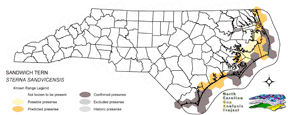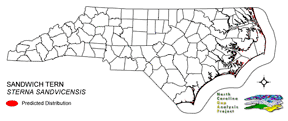
| Taxa: |
| Order: |
| Family: |
| Aves |
| Charadriiformes |
| Laridae |
| NatureServe Global Rank: |
| NatureServe State (NC) Rank: |
| G5 |
| S3B,SZN |
| Federal Status: |
| NC State Status: |
| --- |
| W2,W5 |


| Land Unit |
| US Fish & Wildlife Service |
| US Forest Service |
| US National Park Service |
| US Department of Defense |
| NC State Parks |
| NC University System |
| NC Wildlife Res. Com. |
| NC Forest Service |
| NC Div. of Coastal Mgmt. |
| Local Governments |
| Non-Governmental Org. |
| Other Public Lands |
| Private Lands |
| GAP Status 1-2 |
| All Protected Lands |
| Statewide |
| Hectares |
| 13,705.56 |
| 139.14 |
| 6,308.10 |
| 9,548.55 |
| 1,700.64 |
| 0.00 |
| 3,671.01 |
| 0.00 |
| 1,593.81 |
| 2.52 |
| 1,679.76 |
| 34.65 |
| 58,384.53 |
| 26,800.20 |
| 37,902.78 |
| 96,768.27 |
| Acres |
| 33,867.17 |
| 343.82 |
| 15,587.65 |
| 23,594.98 |
| 4,202.37 |
| 0.00 |
| 9,071.26 |
| 0.00 |
| 3,938.39 |
| 6.23 |
| 4,150.78 |
| 85.62 |
| 144,271.29 |
| 66,224.72 |
| 93,659.79 |
| 239,119.56 |
| % of Dist. on |
| Prot. Lands |
| 36.2 % |
| 0.4 % |
| 15.4 % |
| 25.2 % |
| 4.5 % |
| 0.0 % |
| 9.7 % |
| 0.0 % |
| 4.2 % |
| 4.4 % |
| 4.4 % |
| < 0.1 % |
| 0.0 % |
| 70.7 % |
| ----- |
| ----- |
| % of Dist. on |
| All Lands |
| 14.2 % |
| 0.1 % |
| 6.5 % |
| 9.9 % |
| 1.8 % |
| 0.0 % |
| 3.8 % |
| 0.0 % |
| 1.6 % |
| < 0.1 % |
| 1.7 % |
| < 0.1 % |
| 60.3 % |
| 27.7 % |
| ----- |
| ----- |
|
Nests in several colonies on the barrier islands (Portnoy 1981). Nests locally on sandy ocean beaches on the barrier islands (Portnoy 1981), almost always in association with Royal Terns. Prefers warm fairly shallow waters such as bays and estuaries near large beaches and mudflats, but also forages by diving a distance out in the ocean and also by hawking insects in flight (Ehrlich et al. 1988) Nests in an open area (Kaufman 1996) on bare sand above the high water mark, occasionally among shells (Ehrlich et al. 1988). NATURE SERVE GLOBAL HABITAT COMMENTS: Seacoasts, bays, estuaries, mudflats, river mouths, lagoons. In North America, nests with royal tern on unvegetated bare sand or sand-shell substrates on barrier beaches, sandflats, or dredge-spoil islands; sometimes in association with laughing gull or black skimmer. Colonies occur on dredged material islands in North Carolina, on barrier islands in South Carolina, both types of sites in Florida and Texas; the largest colonies in Louisiana occur on barrier beaches of Chandeleur Islands (Spendelow and Patton 1988). |
| Code | Name | Description | NC Natural Heritage Program Equivalent |
| 378 | Ocean Beaches | Open beach sand. | Upper Beach |
| 3 | Tidal Marsh | Fresh and brackish tidal marshes, including cord grass, wild rice, sawgrass and needlerush alliances. | Brackish Marsh, Interdune pond, Maritime wet grassland |
| 375 | Hypersaline coastal salt flats | Tidal flats within salt marshes, including saltmeadow cordgrass or sea-purslane dominated alliances. | Salt Marsh |
| 372 | Interdune Herbaceous Wetlands | Dune swales with permanently flooded to intermittently exposed hydrology. Species composition depends on salinity and can include cut grass, spike-rush, mosquito fern, and hornwort. | Interdune Pond, Maritime Wet Grasslands |
| 371 | Maritime Grasslands | Dune grass community consisting of sea oats and beach grasses. | Dune grass, Maritime dry grassland |
| 8 | Open water | Open water without aquatic vegetation. | No equivalent |
|
Bent, A.C. 1921. Life histories of North American gulls and terns. U.S. Natl. Mux. Bull. 113. Washington, D.C.
Kaufman K. 1996. Lives of North American Birds. Boston, New York: Houghton Mifflin Company. Barcena, F., A. M. Teixeira, and Andres Bermejo. 1984. Breeding seabird populations in the Atlantic sector of the Iberian Peninsula. Pages 335-345 in Croxall et al., eds. Status and conservation of the world's seabirds. ICBP Tech. Pub. No. 2. Buckley, P. A., and F. G. Buckley. 1984. Seabirds of the north and middle Atlantic coast of the United States:their status and conservation. Pages 101-133 in Croxall et al., eds. Status and conservation of the world's seabirds. ICBP Tech. Pub. No. 2. Clapp, R. B., and P. A. Buckley. 1984. Status and conservation of seabirds in the southeastern United States. Pages 135-155 in Croxall et al., eds. Status and conservation of the world's seabirds. ICBP Tech. Pub. No. 2. Evans, P. G. H. 1984. Status and conservation of seabirds in northwest Europe (excluding Norways and the USSR). Pages 293-321 in Croxall et al., eds. Status and conservation of the world's seabirds. ICBP Tech. Pub. No. 2. James, P. C. 1984. The status and conservation of seabirds in the Mediterranean region. Pages 371-375 in Croxall et al., eds. Status and conservation of the world's seabirds. ICBP Tech. Pub. No. 2. Harrison, C. 1978. A field guide to the nests, eggs and nestlings of North American birds. Collins, Cleveland, Ohio. Sprunt, A., IV. 1984. The status and conservation of seabirds of the Bahama Islands. Pages 157-168 in Croxall et al., eds. Status and conservation of the world's seabirds. ICBP Tech. Pub. No. 2. van Halewyn, R., and R. L. Norton. 1984. The status and conservation of seabirds in the Caribbean. Pages 169-222 in Croxall et al., eds. Status and conservation of the world's seabirds. ICBP Tech. Pub. No. 2. Terres, J.K. 1980. The Audubon Society encyclopedia of North American birds. Alfred A. Knopf, New York. Wiley, J. W. 1985. Bird conservation in the United States Caribbean. Pages 107-159 in Temple, S. A., editor. Bird conservation 2. Univ. Wisconsin Press, Madison. 181 pp. American Ornithologists' Union (AOU), Committee on Classification and Nomenclature. 1983. Check-list of North American Birds. Sixth Edition. American Ornithologists' Union, Allen Press, Inc., Lawrence, Kansas. Raffaele, H.A. 1983. A guide to the birds of Puerto Rico and the Virgin Islands. Fondo Educativo Interamericano, San Juan, Puerto Rico. 255 pp. Ehrlich, P.R., D.S. Dobkin, and D. Wheye. 1988. The birder's handbook:a field guide to the natural history of North American birds. Simon and Shuster, Inc., New York. xxx + 785 pp. Spendelow, J.A., and S.R. Patton. 1988. National atlas of coastal waterbird colonies in the contiguous United States:1976-1982. U.S. Fish and Wildlife Service, Biological Report 88(5). x + 326 pp. Byrd, M.A., and D.W. Johnston. 1991. Birds. Pages 477-537 in K. Terwilliger, coordinator. Virginia's endangered species:proceedings of a symposium. McDonald and Woodward Publ. Co., Blacksburg, Virginia. Stiles, F.G., and A.F. Skutch. 1989. A guide to the birds of Costa Rica. Comstock Publ. Associates, Cornell University Press, Ithaca, New York. 511 pp. |
For more information please contact them at:
NC-GAP Analysis Project
Dept. of Zoology, NCSU
Campus Box 7617
Raleigh, NC 27695-7617
(919) 513-2853
www.basic.ncsu.edu/ncgap